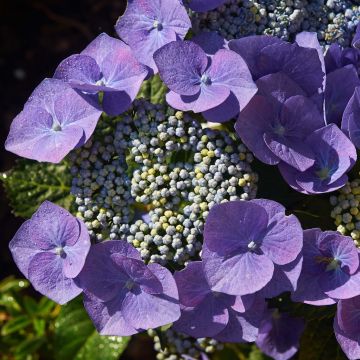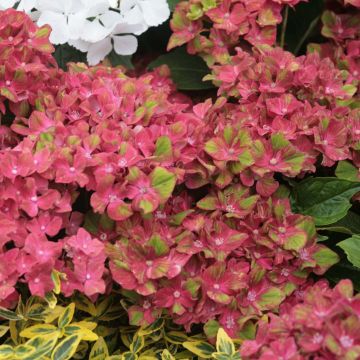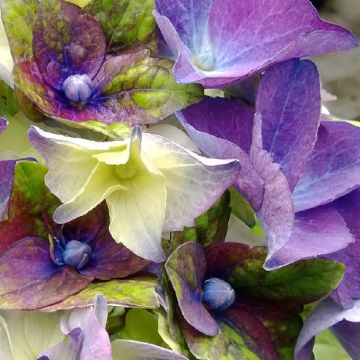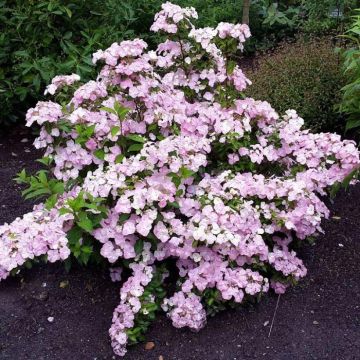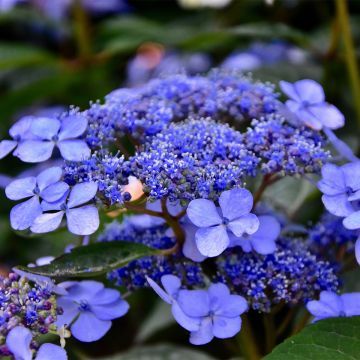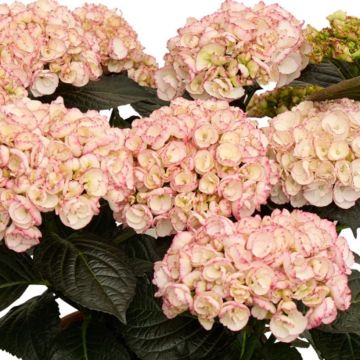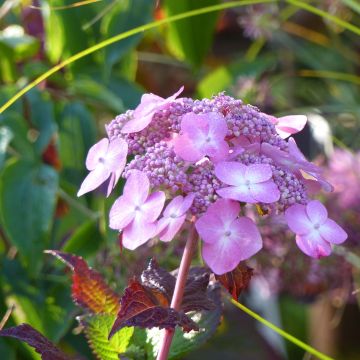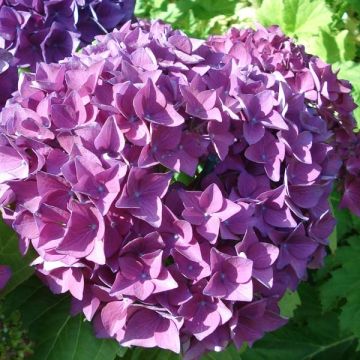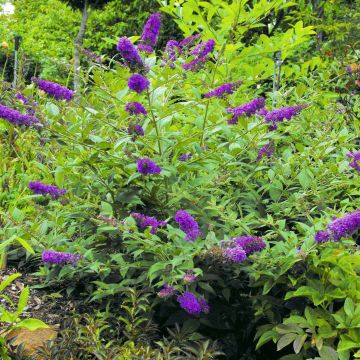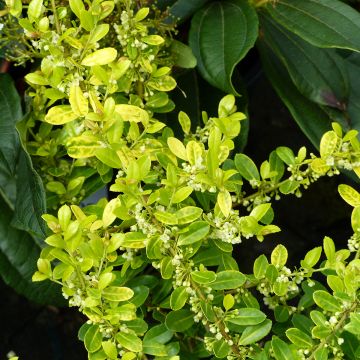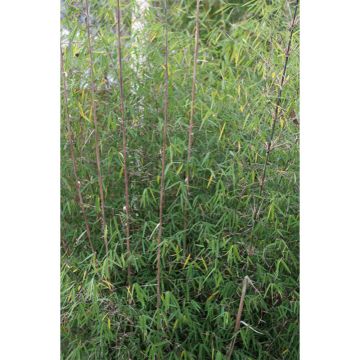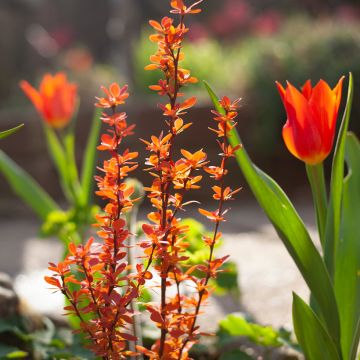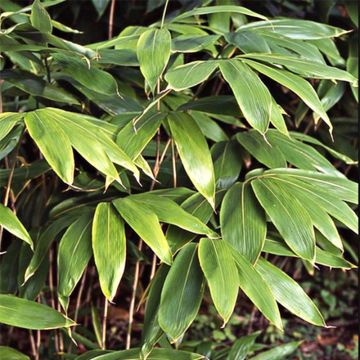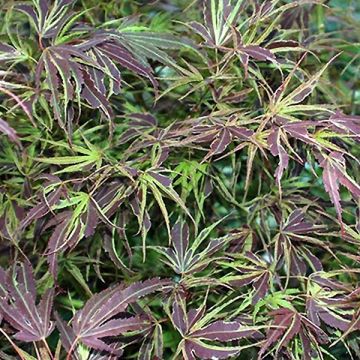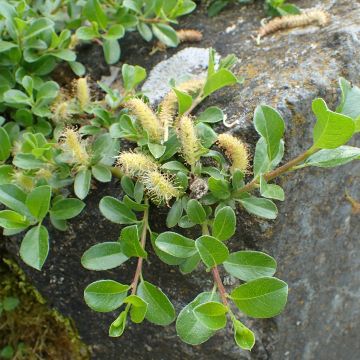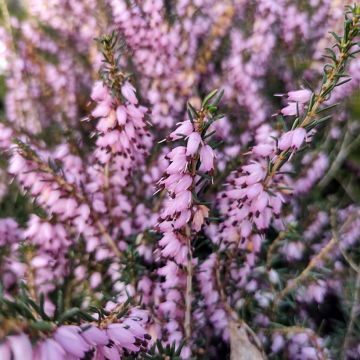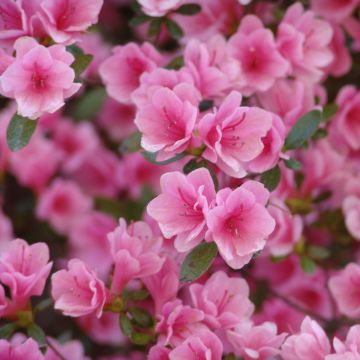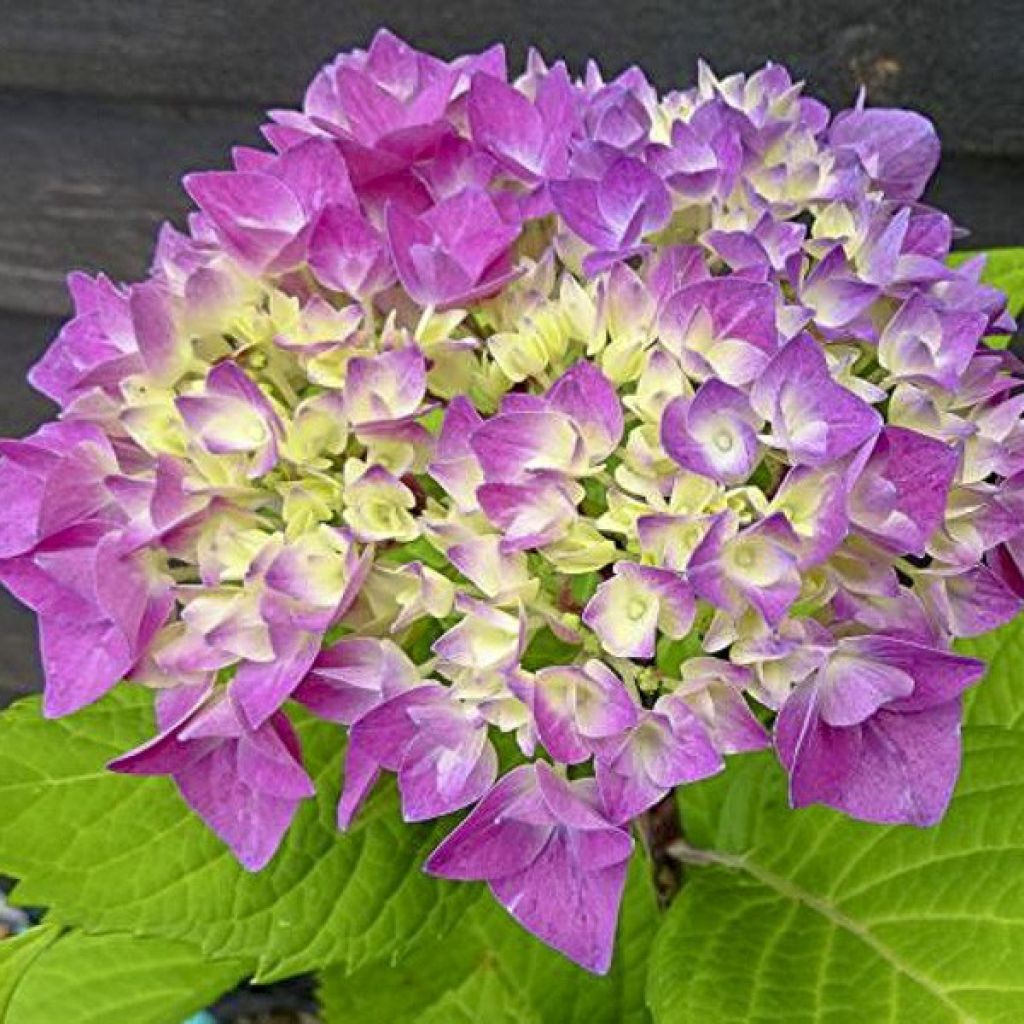

Hydrangea macrophylla Flair & Flavours Sweet Cupcake
Hydrangea macrophylla Flair & Flavours Sweet Cupcake
Hydrangea macrophylla Flair & Flavours Sweet Cupcake
Bigleaf Hydrangea, French Hydrangea
This item cannot be shipped to the selected country
Delivery charge from €5.90
More information
Schedule delivery date,
and select date in basket
This plant carries a 24 months recovery warranty
More information
We guarantee the quality of our plants for a full growing cycle, and will replace at our expense any plant that fails to recover under normal climatic and planting conditions.
From €5.90 for pickup delivery and €6.90 for home delivery
Express home delivery from €8.90.
Does this plant fit my garden?
Set up your Plantfit profile →
Description
Hydrangea macrophylla Flair & Flavours Sweet Cupcake displays a spectacular and long-lasting flowering. Its large round inflorescences turn blue in acidic soil, while they turn bright pink in neutral soil. It forms a compact, medium-sized bush with sturdy stems that easily support the inflorescences. It is perfect for creating beautiful dried flower bouquets. This hydrangea is very hardy and should be placed in a semi-shaded position with non-calcareous soil. It is easy to grow, requiring only an annual pruning in spring and regular watering in summer to keep the soil moist.
Hydrangea macrophylla is a deciduous bush native to Japan, where its beauty has been appreciated for centuries and mentioned in poems dating back to the 8th century! In a country that places great importance on plants, festivals are even dedicated to this bush. It is found naturally on the island of Honshu (home to the capital Tokyo) and was introduced to Europe around 1789. This bush is highly regarded by professionals, including nurseries specialising in its production and breeders who have selected dozens of cultivars, as well as enthusiasts.
Sweet Cupcake is a small variety, reaching about 1m (3ft) in all directions. It forms a compact, regular clump with dark green serrated leaves. Its inflorescences appear in July and last until September or October. The regular round heads are made up of 4-sepal flowers, which vary in colour depending on the soil acidity. If the soil is acidic and contains enough aluminium ions, the inflorescences will take on a blue to slightly purplish hue. In neutral or slightly alkaline soil, they will be bright pink. In both cases, it can be said that this beautiful bush has a charming and romantic appeal. In autumn, the foliage usually takes on a beautiful colouration that adds to its ornamental value.
Like all hydrangeas. Sweet Cupcake is not a strictly ericaceous plant, but it prefers neutral to acidic soils. A semi-shaded to shaded exposure in a warm climate suits it well, as well as regular watering in summer because it does not tolerate dryness (of the soil and the atmosphere), which can cause its leaves to wilt. In less sunny climates, it can be planted in an open space. Care consists of an annual pruning in spring, before the new leaves emerge. This bush is hardy (-20°C (-4°F) or more, although severe frost can damage the branch tips. However, they easily regenerate after pruning in spring). It is easy to grow and can live for a very long time.
Sweet Cupcake is ideal for container gardening, on a balcony or a terrace sheltered from afternoon sun. A thick terracotta pot is well suited. If using a plastic container, it is preferable to choose a "double skin" type, with two walls separated by an air gap, providing insulation and preventing excessive heating of the soil and roots in summer, and limiting the effects of freezing in winter. Use ericaceous compost with a bit of compost added. Water regularly during hot periods.
When planted in the garden, you can create beautiful beds under the shade of tall trees by combining this hydrangea with other shrubs that also prefer slightly acidic soils. Choose staggered flowering times to cover the entire season. For example, Hamamelis intermedia 'Diane' will delight you with its delicate red filamentous flowers in the middle of winter, followed by the beautiful small Magnolia stellata and its star-shaped pure white flowers in March-April. Azalea 'Delicatissima' will then reward you with its pleasantly scented pink flowers before passing the baton to our little hydrangea.
Report an error about the product description
Plant habit
Flowering
Foliage
Botanical data
Hydrangea
macrophylla
Flair & Flavours Sweet Cupcake
Hydrangeaeceae
Bigleaf Hydrangea, French Hydrangea
Cultivar or hybrid
Other Hydrangea Macrophylla
Planting and care
Plant in spring or early autumn, preferably in a slightly shaded position, for example against an east-facing wall or even north-facing. In very cold regions, it may be prudent to overwinter it in a cold greenhouse or conservatory. Protect it from cold, drying winds. It does not require acidic soil, but appreciates deep, moist but well-drained, fairly fertile soil, possibly enriched with a good base fertiliser before planting. If planting near a wall and the soil is dry at its base, place the root ball at least 30 to 40cm (12 to 16in) away from it and incorporate a quantity of well-decomposed compost to better retain moisture in the soil. Very hardy, it can be planted in cold regions without fear. Water regularly during hot periods to prevent the foliage from wilting during dry spells.
This variety of hydrangea is also particularly suitable for cultivation in pots or decorative containers due to its relatively compact size. Choose a compound soil for ericaceous plants, and water regularly to keep the substrate moist. In case of cold winter, shelter the pot at the corner of a wall, or even in a garage in case of severe frost, as potted cultivation exposes the roots more to freezing temperatures.
Planting period
Intended location
Care
This item has not been reviewed yet - be the first to leave a review about it.
Shrubs for pots
Haven't found what you were looking for?
Hardiness is the lowest winter temperature a plant can endure without suffering serious damage or even dying. However, hardiness is affected by location (a sheltered area, such as a patio), protection (winter cover) and soil type (hardiness is improved by well-drained soil).

Photo Sharing Terms & Conditions
In order to encourage gardeners to interact and share their experiences, Promesse de fleurs offers various media enabling content to be uploaded onto its Site - in particular via the ‘Photo sharing’ module.
The User agrees to refrain from:
- Posting any content that is illegal, prejudicial, insulting, racist, inciteful to hatred, revisionist, contrary to public decency, that infringes on privacy or on the privacy rights of third parties, in particular the publicity rights of persons and goods, intellectual property rights, or the right to privacy.
- Submitting content on behalf of a third party;
- Impersonate the identity of a third party and/or publish any personal information about a third party;
In general, the User undertakes to refrain from any unethical behaviour.
All Content (in particular text, comments, files, images, photos, videos, creative works, etc.), which may be subject to property or intellectual property rights, image or other private rights, shall remain the property of the User, subject to the limited rights granted by the terms of the licence granted by Promesse de fleurs as stated below. Users are at liberty to publish or not to publish such Content on the Site, notably via the ‘Photo Sharing’ facility, and accept that this Content shall be made public and freely accessible, notably on the Internet.
Users further acknowledge, undertake to have ,and guarantee that they hold all necessary rights and permissions to publish such material on the Site, in particular with regard to the legislation in force pertaining to any privacy, property, intellectual property, image, or contractual rights, or rights of any other nature. By publishing such Content on the Site, Users acknowledge accepting full liability as publishers of the Content within the meaning of the law, and grant Promesse de fleurs, free of charge, an inclusive, worldwide licence for the said Content for the entire duration of its publication, including all reproduction, representation, up/downloading, displaying, performing, transmission, and storage rights.
Users also grant permission for their name to be linked to the Content and accept that this link may not always be made available.
By engaging in posting material, Users consent to their Content becoming automatically accessible on the Internet, in particular on other sites and/or blogs and/or web pages of the Promesse de fleurs site, including in particular social pages and the Promesse de fleurs catalogue.
Users may secure the removal of entrusted content free of charge by issuing a simple request via our contact form.
The flowering period indicated on our website applies to countries and regions located in USDA zone 8 (France, the United Kingdom, Ireland, the Netherlands, etc.)
It will vary according to where you live:
- In zones 9 to 10 (Italy, Spain, Greece, etc.), flowering will occur about 2 to 4 weeks earlier.
- In zones 6 to 7 (Germany, Poland, Slovenia, and lower mountainous regions), flowering will be delayed by 2 to 3 weeks.
- In zone 5 (Central Europe, Scandinavia), blooming will be delayed by 3 to 5 weeks.
In temperate climates, pruning of spring-flowering shrubs (forsythia, spireas, etc.) should be done just after flowering.
Pruning of summer-flowering shrubs (Indian Lilac, Perovskia, etc.) can be done in winter or spring.
In cold regions as well as with frost-sensitive plants, avoid pruning too early when severe frosts may still occur.
The planting period indicated on our website applies to countries and regions located in USDA zone 8 (France, United Kingdom, Ireland, Netherlands).
It will vary according to where you live:
- In Mediterranean zones (Marseille, Madrid, Milan, etc.), autumn and winter are the best planting periods.
- In continental zones (Strasbourg, Munich, Vienna, etc.), delay planting by 2 to 3 weeks in spring and bring it forward by 2 to 4 weeks in autumn.
- In mountainous regions (the Alps, Pyrenees, Carpathians, etc.), it is best to plant in late spring (May-June) or late summer (August-September).
The harvesting period indicated on our website applies to countries and regions in USDA zone 8 (France, England, Ireland, the Netherlands).
In colder areas (Scandinavia, Poland, Austria...) fruit and vegetable harvests are likely to be delayed by 3-4 weeks.
In warmer areas (Italy, Spain, Greece, etc.), harvesting will probably take place earlier, depending on weather conditions.
The sowing periods indicated on our website apply to countries and regions within USDA Zone 8 (France, UK, Ireland, Netherlands).
In colder areas (Scandinavia, Poland, Austria...), delay any outdoor sowing by 3-4 weeks, or sow under glass.
In warmer climes (Italy, Spain, Greece, etc.), bring outdoor sowing forward by a few weeks.

































